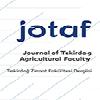Hasat Öncesi ve Hasat Sonrası Laktik Asit Bakteri (LAB) İlavesinin MısırSilaj Fermantasyonu Üzerine Etkileri
Effect of Additional of Lactic Acid Bacteria (LAB) InoculantsPre-harvest and Post-harvest Silage Ferrmantation of Corn Silage
___
- Basmacıoğlu H, Ergül M, Karaayvaz K 2002. Mısır Silajında Kullanımının Silaj Kalitesi ve Yem Değerine Etkisi. Ege üniversitesi Bilimsel Araştırma Proje Raporu, proje No: 2000 ZRF-015, Bornova, İZMİR. İnokulant
- Chen J, Stokes MR, Wallace CR 1994. Effects of Enzyme- Inoculant Systems on Preservation and Nutritive Value of Hay Crop and Corn Silages, J. Dairy Sci., 77: 501-512.
- Filya İ. 2002b. Laktik Asit Bakteri İnokulantlarının Mısır ve Sorgum Silajlarının Fermantasyon, Aerobik Stabilite ve in situ Rumen Parçalanabilirlik Özellikleri Üzerine Etkileri. Turk J Vet Animal Sci, 26:815-823.
- Filya İ, Sucu E and Karabulut A 2006. The Effect of Lactobacillus buchneri on the Fermentation, Aerobic Stability and Ruminal Degradability of Maize Silage. Journal of Applied Microbiol., 101:1216-1223.
- Meeske R, Basson HM (1998). The effects of a lactic acid bacteria inoculant on maize silage. Animal Feed Sci. and Technology, 70: 239-247.
- Pahlow G 1986. Microbiology of Inoculants, Crops and Silages-Small Proceedings of the Eurobac Conference ed. Lindgren, S.E. & Patterson, K.L. Uppsala, Sweden University of Agricultural Science, pp. 45-59. Experiments. In
- Petterson K 1988. Ensiling of Forages: Factors Affecting Silage Lantbruksuniversitet, 46 p, Uppsala. Quality, Sveriges
- Polat C, Koç F, Özdüven ML 2005, Mısır Silajında Laktik Asit Bakteri ve Laktik Asit Bakteri+Enzim Karışımı İnokulantların Fermantasyon ve Toklularda Ham Besin Maddelerinin Sindirilme Dereceleri Üzerine Etkileri. Tkirdağ Ziraat Fakültesi Dergisi, 2(1): 13-22.
- Soysal M.İ. 1998. Biyometrinin Prensipleri (İstatistik I ve II Ders Notları), Yayın No: 95, Ders Kitabı No: 64, T.Ü. Tekirdağ Ziraat Fakültesi, 331 s, Tekirdağ.
- Tengerdy RP, Weinberg ZG, Szakacs G, Wu M, Linden JC, Johnson DE 1991. Ensiling alfalfa with additives of lactic acid bacteria and enzymes. J. Sci. Food Agric., 55: 215-228.
- Weinberg ZG, Ashbell G, Hen Y, Azrieli A (1993). The Effect of Applying Lactic Acid Bacteria Ensiling on the Aerobic Stability of Silages. J. Appl. Bacteriol., 75: 512-518.
- Yurtman İY, Koç F, Özdüven ML, Erman S 1997. Silaj Üretiminde Mikrobiyal Katkı Maddelerinin Kullanımı.Trakya Bölgesi II. Hayvancılık Sempozyumu.
- ISSN: 1302-7050
- Yayın Aralığı: 3
- Başlangıç: 2004
- Yayıncı: Namık Kemal Üniv. Tekirdağ Ziraat Fak.
İzmir İli Güney Hattı Şeftali (prunus persica) Bahçelerinin Beslenme Durumlarının İncelenmesi
Seda ERDOĞAN BAYRAM, Ömer Lütfü ELMACI, Nejat ÖZDEN
Burak KARA, CEMAL POLAT, FİSUN KOÇ
İzmir İli Güney Hattı Şeftali (Prunus persica L.) Bahçelerinin Beslenme Durumlarının İncelenmesi
Seda Erdoğan BAYRAM, ÖMER LÜTFÜ ELMACI, Nejat ÖZDEN
M.ömer AZABAĞAOĞLU, Derya İlkay ABDİKOĞLU, Gökhan UNAKITAN
Ertuğrul BIGUCU, BİNNUR KAPTAN, İBRAHİM PALABIYIK, Omer OKSUZ
Fulya TAN, CİHANGİR SAĞLAM, Güven AKAR
Consumer's Fish Purchase Behavior in Tekirdag
Gökhan UNAKITAN, M Ömer AZABAĞAOĞLU, D İlkay ABDİKOĞLU
